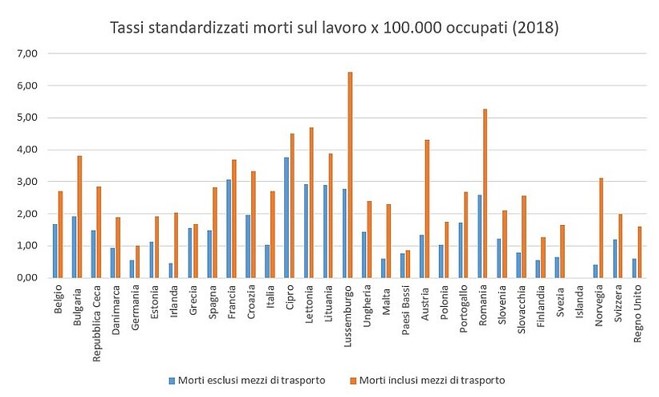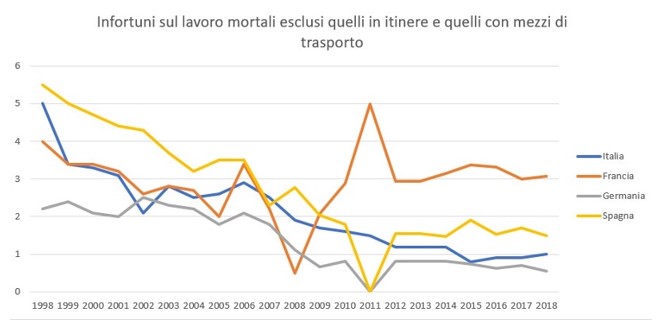Deaths and accidents at work: numbers, comparisons and surprises

Deaths and accidents at work: the numbers show that Italy does better than many European countries and is in line with the more industrialized ones. The deepening of Giuliano Cazzola and the analysis of the Liberi Oltre association
I discovered the existence of an association of '' cliché hunters ''; it is called '' Free beyond illusions '' and sets itself the goal of countering the cultural decline of Italy.
The note of 7 February deals with a delicate topic, that of accidents at work, on the basis of a historical and international comparison. It is very risky to venture on a path made of suffering and deaths: even a single death at work is a dramatic and unacceptable event, because in addition to the drama of the person and his loved ones, an inadequacy of the prevention and safety measures emerges. constitute a specific commitment connected to the employment relationship and sanctioned by law and contracts, protected by the relevant services.
'' When an accident at work occurs with a fatal outcome –writes Costantino de Blasi, expert in risk management – great discussions are held in the media about white deaths, about the infinite massacre, about the lack of security; there is never an in-depth analysis of the causes and incidence of these accidents ''.
But the issue is addressed as if deaths in the workplace were an Italian peculiarity. Thus, after having summarized the evolution of the legislation on safety in the workplace (from the legislative decree n.626 / 1994 to the legislative decree n.81 / 2008 and subsequent amendments and additions), the author recalls the data reported in an article published on January 26 last year. in Repubblica signed by Marco Bentivogli, where it was recalled that according to INAIL surveys between 1971 and 1980 the average deaths in the workplace was 8.1 per day, between 1981 and 1990 it was 5.7 per day, between 1991 and 2000 was 4.1; between 2001 and 2020 around 3.5.
Therefore, net of other factors, the legislation seems to have reduced the massacre, even if the numbers remain, still too high. From this bitter observation – which is still a trend to be taken into account in order to do even better – the note spreads on what is happening in the main European countries, more swamped than Italy in our own consideration.
Costantino de Blasi warns that one of the difficulties of a comparative analysis lies in the non-homogeneity of the surveys. With regard to accidents, for example, some European countries do not include those in intinere (journey home to work and return), or they detect occupational diseases in a different way from the accident, or still use systems for collecting and cataloging the data other than those required by public insurance (in the case of Italy, INAIL). Therefore, the author declares that he has tried to normalize the data in order to be able to make a comparison as coherent as possible, starting by excluding in the tables and graphs the accidents while commuting (which actually occur during work, but concern more to traffic and communications problems.
In 2018, the year in which data collection by INAIL stops, in the Europe of 27 there were 3.1 million accidents at work out of 188 million employed, with an accident rate of 1.66% . The incidence of accidents on the total number of employees for the 4 main countries is summarized in the following table:

A substantial part of accidents with fatal outcomes are due to those caused by means of transport (trucks, public transport, goods handling, etc.). The considerable difference in tragic outcomes with and without means of transport is shown in the following graph. For our country, the rate goes from 1.04 to 2.70.

The trend analysis shows a clear and constant improvement in the incidence rate of accidents in the workplace with a fatal outcome for all the countries considered with the exception of France. Considering a sufficiently long period of time, 1998-2018, and excluding both those in itinere and those with means of transport, the improvement – it is written in the note – is particularly sensitive for Italy and Spain and more limited for Germany which, however, started from data already low.

In 2018, there were 291,000 injuries in Italy, 523 of which resulted in fatal outcomes. The accident fatality rate was 0.179%.
The note, therefore, reaches the following conclusions: the data show that there is no Italian anomaly. The numbers show that Italy does better than many European countries and is in line with the more industrialized ones. The effects of Law 626/94 before and of Legislative Decree 81/2008 after are clearly visible and the prevention and control obligations introduced by the regulations have significantly mitigated the number of accidents.
It is right to underline that any accident would be avoidable and it is right to complain and ask for interventions when these accidents cause the death of a worker; but it is also appropriate to consider what has been done and how the accidents are not anomalous and, once again, the zero risk does not exist.
Since so far we have talked about accidents at work, I would like to add some considerations regarding accidents from Covid-19, carried out on the basis of a comparison of data, from INAIL source, before and after the mass vaccination campaign and the adoption of the relative measures for access to the workplace (green pass, etc.). To understand the benefits that the administration of vaccines has produced in the world of work, it is sufficient to read the 2020 data: the 148,485 infections reported, in that year, amounted to 77.7% of all cases of contagion received up to 31 December. 2021, with November (40,661 reports) the month with the highest number of events, followed by March with 28,688 cases.
As for fatal cases, in the year 2020, the 568 deaths from Covid-19 represented 70.0% of all fatal cases from contagion received up to 31 December 2021; the month of April 2020 (197 deaths) found the highest number of events, followed by March with 142 cases. In general, if in the year 2020 the average incidence of reports from Covid-19 on the total of all accidents reported was one in four, in the first ten months of 2021 it dropped to one in thirteen. It is good to consider this time frame because it is that of the turning point in the vaccination campaign, since green certification is also the main novelty that has occurred, by way of prevention, in companies since the resumption of activities after the summer break last year.
I wanted to report this type of accidents separately because of their particularity (I could even venture the term '' exceptionality '', at least until the outbreak of the pandemic) and because I believe it necessary to take them into account in the total count of accidents at work.
This is a machine translation from Italian language of a post published on Start Magazine at the URL https://www.startmag.it/economia/morti-infortuni-lavoro-italia/ on Wed, 09 Feb 2022 07:20:21 +0000.
